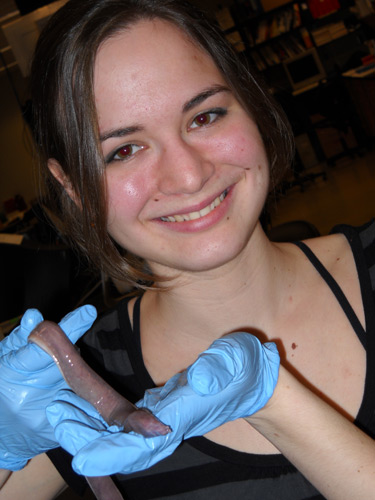
They look simple enough, nestled at the bottom of a water-filled plastic pail like discarded lengths of grey-brown garden hose. But U of G biologist Doug Fudge says there’s nothing simple about those hagfish or the gloopy slime they can produce by the bucketful when provoked.
Research by the integrative biology professor has uncovered the slime “recipe” and explained how these sea-dwellers make and deploy that slippery blob. Two research papers on the subject were published in March in the Journal of Experimental Biology. But Fudge says there’s still plenty to learn, including how the creatures keep the substance stable in their bodies until they’re ready to “slime” a predator within a fraction of a second.
Referring to the hagfish’s ability to squirt copious amounts of viscous slime from glands running down both sides of its body, he says: “I’ve never seen anyone who’s not impressed.”
Sliming is believed to be a defensive mechanism, as the material gums up the gills of fish. But how does it happen?
Mixing and mucous are key.
Through tests in his science complex lab, Fudge found that slime largely consists of coiled bundles, or skeins, of protein fibres along with vesicles containing mucous. Mixing the vesicles in water makes the mucous strands stretch, in turn causing the skeins to rapidly unravel in what he calls a “magical transition” and trap large amounts of seawater.
Simply adding water is not enough. In the creatures’ marine home on the Atlantic or Pacific coast, it’s the agitation of mixing that causes the thread skeins to uncoil and attract the mucous released from ruptured vesicles. In his lab, Fudge and undergraduate student Tim Winegard made special glass chambers and used fluorescent dyes to capture the action under the microscope.
Fudge says other fish species, notably lampreys, have thread skein cells in their skin. But lampreys don’t eject slime. Mucous vesicles likely evolved first in hagfish, which appeared about 330 million years ago.
He believes there may be a way to mimic the process in certain industrial applications involving transmission of hydrodynamic forces on a small scale.
The Fudge research team’s second paper describes the contents of the slime, particularly large amounts of methylamines as well as various ions. The researchers had thought that the methylamines helped to stabilize the mucous vesicles inside the slime glands. The same substance helps sharks prevent loss of body fluids to seawater.
“We expected to see that methylamines were good at preventing vesicle rupture,” says Fudge, but more tests in special chambers found that these organic compounds failed to stop vesicle bursting. “That was really surprising to us — we still don’t understand it.”
He thinks the chemical environment or hydrostatic pressure inside the mucous glands might help stabilize the vesicles.
Several researchers worked on that study, including lead author Julia Herr, who completed her B.Sc. last year and has begun a master’s degree in Fudge’s biomaterials lab. She recalls her initial reaction to slime as an undergrad: “That’s gross; but that’s really neat, too.”
Fudge says this is basic research that could have medical applications. Slime threads are an example of cell filaments; other filament proteins are involved in a skin-blistering disease as well as development of eye cataracts.